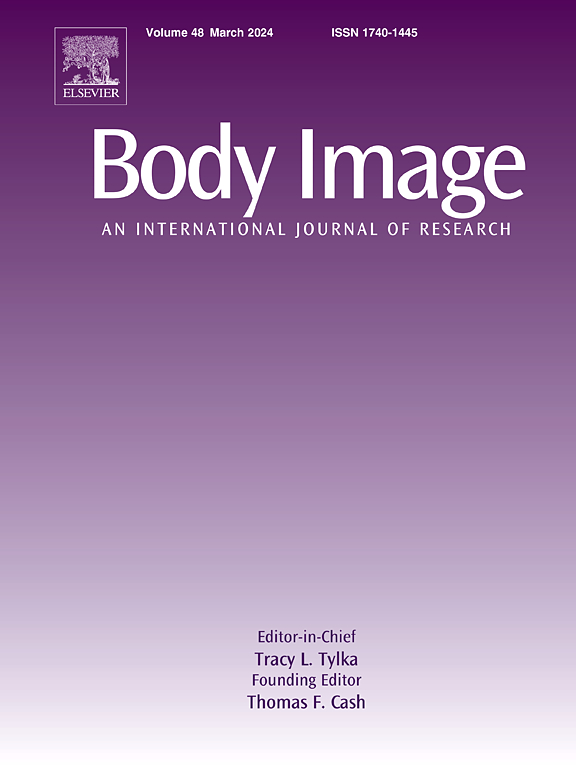探索视觉和言语免责对社交网络用户正面身体形象的保护作用:一项实验研究
IF 5.4
1区 心理学
Q1 PSYCHIATRY
引用次数: 0
摘要
鉴于积极的身体形象与广泛的幸福指标相关,制定有效的策略来保护社交网络(SN)用户免受潜在有害的SN内容的影响是很重要的。本实验研究的目的是评估年轻女性接触数字修改的图像,结合口头和视觉免责声明,对积极的身体形象(身体欣赏,身体功能欣赏和身体满意度)的影响。在本研究中,270名女性SN用户(M = 21.55;SD=3.31)的参与者被暴露在以下四种条件中的一种:对照(中性图片)、仅编辑过的图片(数字修改过的女性身体图片)、视觉免责声明(编辑前和编辑后的女性身体对比图片)、视觉+口头免责声明(修饰过和未修饰过的女性身体对比图片,并附有口头免责声明)。与我们的假设部分一致,协方差分析(ANCOVA)显示,接触视觉免责或视觉+口头免责条件的参与者报告的身体满意度高于对照组。控制组的女性对身体的满意度与只看编辑过的照片的女性没有什么不同。此外,在视觉+口头免责条件下的参与者与视觉免责条件下的参与者之间没有差异。与我们的假设相反,结果表明对身体欣赏或身体功能欣赏没有影响。这些发现可能对制定旨在提高年轻女性SN用户身体满意度的策略具有启示意义。本文章由计算机程序翻译,如有差异,请以英文原文为准。
Exploring the protective role of visual and verbal disclaimers on social networks users’ positive body image: An experimental study
Given that positive body image is correlated with a wide range of well-being indicators, it is important to develop effective strategies to protect users of social networks (SN) from potentially harmful SN content. This experimental study aimed to assess the impact of exposure to digitally altered images of young women, combined with verbal and visual disclaimers, on positive body image (body appreciation, body functionality appreciation and body satisfaction). For this study, 270 female SN users (M = 21.55; SD=3.31) were exposed to one of four conditions: Control (neutral images), only edited images (images of digitally altered women’s bodies), visual disclaimer (images of comparisons between pre and post-edited women’s bodies), visual + verbal disclaimer (images of comparisons between retouched and unretouched women’s bodies accompanied by a verbal disclaimer). Partially in line with our hypotheses, analyses of covariance (ANCOVA) showed that participants exposed to the visual disclaimer or visual + verbal disclaimer conditions reported higher body satisfaction than those in the control group. The body satisfaction of women in the control group did not differ from that of women who saw only edited images. Moreover, no differences emerged between participants in the visual + verbal disclaimer condition and those in the visual disclaimer condition. Contrary to our hypotheses, the results indicated no impact on body appreciation or body functionality appreciation. These findings may have implications for the development of strategies aimed at increasing body satisfaction among young female users of SN.
求助全文
通过发布文献求助,成功后即可免费获取论文全文。
去求助
来源期刊

Body Image
Multiple-
CiteScore
8.70
自引率
28.80%
发文量
174
期刊介绍:
Body Image is an international, peer-reviewed journal that publishes high-quality, scientific articles on body image and human physical appearance. Body Image is a multi-faceted concept that refers to persons perceptions and attitudes about their own body, particularly but not exclusively its appearance. The journal invites contributions from a broad range of disciplines-psychological science, other social and behavioral sciences, and medical and health sciences. The journal publishes original research articles, brief research reports, theoretical and review papers, and science-based practitioner reports of interest. Dissertation abstracts are also published online, and the journal gives an annual award for the best doctoral dissertation in this field.
 求助内容:
求助内容: 应助结果提醒方式:
应助结果提醒方式:


